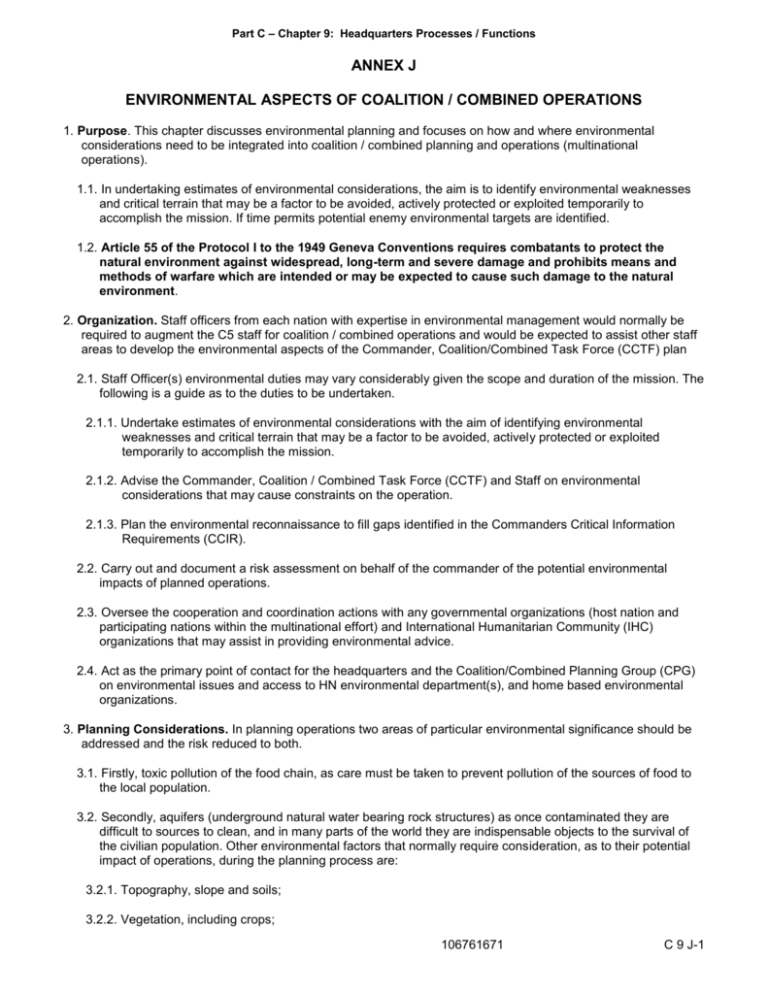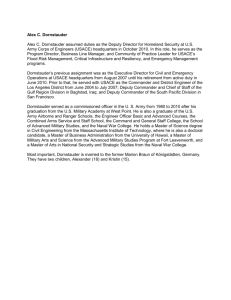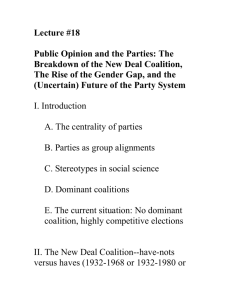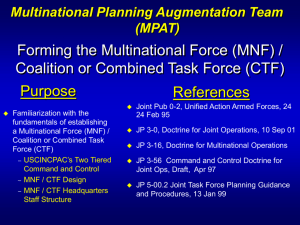Annex F - Nuclear, Biological, and Chemical (NBC) Operations
advertisement

Part C – Chapter 9: Headquarters Processes / Functions ANNEX J ENVIRONMENTAL ASPECTS OF COALITION / COMBINED OPERATIONS 1. Purpose. This chapter discusses environmental planning and focuses on how and where environmental considerations need to be integrated into coalition / combined planning and operations (multinational operations). 1.1. In undertaking estimates of environmental considerations, the aim is to identify environmental weaknesses and critical terrain that may be a factor to be avoided, actively protected or exploited temporarily to accomplish the mission. If time permits potential enemy environmental targets are identified. 1.2. Article 55 of the Protocol I to the 1949 Geneva Conventions requires combatants to protect the natural environment against widespread, long-term and severe damage and prohibits means and methods of warfare which are intended or may be expected to cause such damage to the natural environment. 2. Organization. Staff officers from each nation with expertise in environmental management would normally be required to augment the C5 staff for coalition / combined operations and would be expected to assist other staff areas to develop the environmental aspects of the Commander, Coalition/Combined Task Force (CCTF) plan 2.1. Staff Officer(s) environmental duties may vary considerably given the scope and duration of the mission. The following is a guide as to the duties to be undertaken. 2.1.1. Undertake estimates of environmental considerations with the aim of identifying environmental weaknesses and critical terrain that may be a factor to be avoided, actively protected or exploited temporarily to accomplish the mission. 2.1.2. Advise the Commander, Coalition / Combined Task Force (CCTF) and Staff on environmental considerations that may cause constraints on the operation. 2.1.3. Plan the environmental reconnaissance to fill gaps identified in the Commanders Critical Information Requirements (CCIR). 2.2. Carry out and document a risk assessment on behalf of the commander of the potential environmental impacts of planned operations. 2.3. Oversee the cooperation and coordination actions with any governmental organizations (host nation and participating nations within the multinational effort) and International Humanitarian Community (IHC) organizations that may assist in providing environmental advice. 2.4. Act as the primary point of contact for the headquarters and the Coalition/Combined Planning Group (CPG) on environmental issues and access to HN environmental department(s), and home based environmental organizations. 3. Planning Considerations. In planning operations two areas of particular environmental significance should be addressed and the risk reduced to both. 3.1. Firstly, toxic pollution of the food chain, as care must be taken to prevent pollution of the sources of food to the local population. 3.2. Secondly, aquifers (underground natural water bearing rock structures) as once contaminated they are difficult to sources to clean, and in many parts of the world they are indispensable objects to the survival of the civilian population. Other environmental factors that normally require consideration, as to their potential impact of operations, during the planning process are: 3.2.1. Topography, slope and soils; 3.2.2. Vegetation, including crops; 106761671 C 9 J-1 Part C – Chapter 9 – Annex J 3.2.3. Wildlife and its habitat; 3.2.4. Listed threatened species and ecological communities; 3.2.5. Listed migratory species; 3.2.6. Whales and other cetaceans; 3.2.7. Ramsar Convention on Wetlands areas of international importance; 3.2.8. World heritage properties; 3.2.9. National heritage places; 3.2.10. Indigenous and historical heritage; 3.2.11. National parks, marine parks and other protected areas; 3.2.12. Air quality; 3.2.13. Water quality; 3.2.14. Hazardous material, hazardous waste disposal and potential cleanup requirements; 3.2.15. Land and facility use, occupation and return; and 3.2.16. Socio-economic and political sensitivities and desired end states relevant to, or functions of, environmental conditions. 3.3. Environmental considerations may make it prudent to focus some of the Operational Intelligence Preparation of the Environment (OIPE) support to assist in site selection for units moving into an operational area. Environmentally sensitive areas can be labeled as environmental areas of interest (AI). Environmental AI includes both natural and man-made features. (Refer to Part B, Chapter 2, Annex B: CTF Planning Process for the components of the OIPE and planning process.) 3.4. Higher headquarters’ orders need to be examined to determine which environmental considerations should be noted as specified, implied and essential tasks. The mission determines if environmental considerations are essential tasks. If, for example, the mission is focused on response to a natural or manmade emergency, it is more likely that environmental considerations will be important and take precedence. 3.5. Environmental considerations may cause constraints on an exercise or operation. These constraints must be identified and understood. They will normally be found in the scheme of maneuver, concept of operations, and the coordinating instructions. Written orders would normally have critical environmental constraints placed at the beginning of the body of the order and not relegated to an annex or appendix. 3.6. The CCIR identifies information that the commander needs to support the CCTF’s operational area visualization and to make critical decisions. Environmental considerations will likely be part of the CCIR. 3.7. Gaps in the CCIR normally trigger reconnaissance activity to fill those gaps. These may include an environmental reconnaissance, which may be defined as the systematic observation and recording of site or area data collected by visual or physical means, dealing specifically with environmental conditions as they exist, and identifying areas that are environmentally sensitive or of relative environmental concern, for information and decision-making purposes. Reconnaissance of sites that may become base camps, deployment sites, marshalling areas, logistic sites or other critical areas with significant environmental considerations may be included. 3.8. Given that multinational units have regularly deployed to HN areas to either train or operate, planning staff must consider local environmental policies, regulations and international agreements for each country. C 9 J-2 Part C – Chapter 9 – Annex J 3.9. It is important to recognize that many nations within the multinational force will be bound by national and international laws, guidelines, or agreements pertaining to the environment within the world. One example would be that the Australia Defence Forces and its personnel remain bound by the Environment Protection and Biodiversity Conservation Act 1999 anywhere in the world unless an exemption has been granted by the Commonwealth Minister for the Environment. The National Command Elements (NCEs) within the CTF headquarters should be required to maintain any and all environmental agreements for their respective nation’s forces. 4. Damage to the Environment. 4.1. During execution of operations, a balance needs to be struck between the achievement of objectives and minimizing damage to infrastructure and the environment. Unit commanders have initial responsibility for minimizing damage to the environment and must take every opportunity to rectify, or reduce the impact of, damage resulting from their unit activities. Units should attempt to remediate the damage they cause. Damage remediation beyond unit capabilities may be coordinated through the Lead Nation Supported Strategic Commander (and through NCEs with the Supporting Strategic Commanders). Significant environmental damage, particularly affecting air and water quality and nationally significant cultural and heritage sites must be reported immediately to the CTF headquarters. 4.2. Damage remediation is achieved through a progression of the following measures: 4.2.1. Immediate remediation by units. 4.2.2. Remediation is conducted by units as directed by higher headquarters. 4.2.3. After an operation remediation is conducted by assigned damage control units. 4.2.4. Remediation is undertaken by civil contractors during or after the operation, but prior to the handover of bases to the HN or follow on coalition forces. 4.3. Prior to abandoning or leaving contingency bases an Environmental Closure Plan (ECP) shall be developed that gives units adequate guidance and direction to close and transfer the property to either the host nation (HN) or other coalition forces. 4.4. It is highly recommended that an ECP be put in place 60 days prior to the property transfer. At 30 days prior to closure, a Preliminary Closure Survey (PCS) should take place, and 24 hours before departure of the force a Final Closure Survey should be completed clearing the way for the formal signing and exchange of an Environmental Compliance Certificate (ECC) with either the HN or follow on coalition forces. 5. Summary. Environmental issues should be considered as early as possible in the planning of operations. Such planning is integral factor for successful multinational operations. 5.1. The law of armed conflict containing provisions for environmental protection can impact on the selection of the weapons used, the method of attack and the scheme of maneuver chosen by the commander. 5.2. The commander needs the best possible advice to fulfill CCIR on the environment before deciding on a final course of action. Environmental specialist staff should be integrated into the CTF headquarters staff to best support the CCTF decision making and to assist CTF components’ environmental planning to minimize environmental issues/problems. The CTF headquarters also needs to maintain the capacity for reach-back to additional specialist advice and guidance from higher headquarters. A risk assessment and damage control plan is required as part of the overall OPLAN/OPORD. C 9 J-3 Part C – Chapter 9 – Annex J PAGE INTENTIONALLY BLANK C 9 J-4









